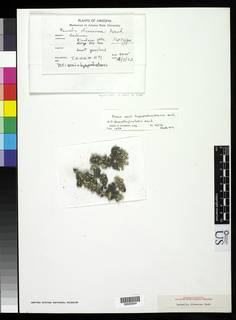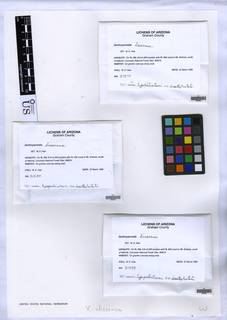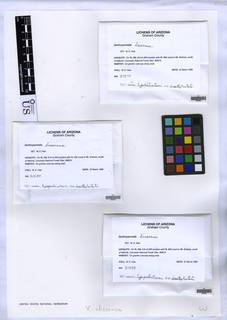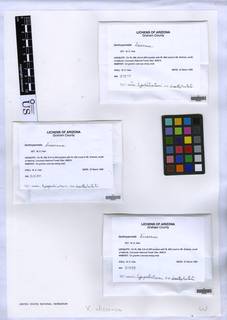
Consortium of Lichen Herbaria
- building a Global Consortium of Bryophytes and Lichens as keystones of cryptobiotic communities -
- Home
- Search
- Images
- Species Checklists
- US States: O-Z >
- US National Parks
- Central America
- South America
- US National Parks
- Southern Subpolar Region
|
|
|
|
Family: Parmeliaceae
[Parmelia dissensa T.H. Nash] |
Nash, T.H., Ryan, B.D., Gries, C., Bungartz, F., (eds.) 2004. Lichen Flora of the Greater Sonoran Desert Region. Vol 2. Thallus: foliose, adnate, 4-20 cm in diam., irregularly lobate lobes: subirregular, elongate, plane to subconvex, separate and contiguous, 1-3 mm wide, not lobulate; apices: subrotund, smooth to crenate, eciliate upper surface: yellow to yellow-green, smooth but becoming strongly rugose with age, dull to slightly shiny, epruinose and emaculate, without soralia, isidia, or pustulae medulla: white, with continuous algal layer lower surface: black; plane, sparsely rhizinate; rhizines: black, simple, 0.5-0.8 mm long Apothecia: not observed Pycnidia: common, immersed conidia: bifusiform, 5-6 x 1 µm Spot tests: upper cortex K-, C-, KC-, P-; medulla K-, C-, KC-, P- Secondary metabolites: upper cortex with usnic acid (major); medulla with hypoprotocetraric acid (major) and 4-O-demethylnotatic acid (submajor) and conhypoprotocetraric acid (trace). Substrate and ecology: on acidic rocks, often in open habitats World distribution: North America Sonoran distribution: frequent at lower to intermediate elevations in Arizona, Sonora and western Chihuahua. Notes: Xanthoparmelia dissensa is a broad-lobed species with a black lower cortex and frequently with a rugose upper surface. It is morphologically similar to X. nigropsoromifera, but differs in its spot test reactions (all negative vs. P+ yellow) and in the occurrence of hypoprotocetraric and 4-O-demethylnotatic acids instead of the psoromic acid complex. |
Powered by Symbiota



























